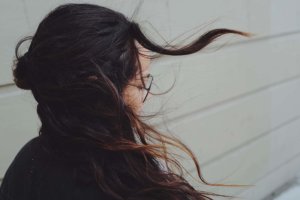Is There a Link Between Dandruff and Hair Loss?
Having a flakey, irritated scalp can do more than just embarrass us: it can also be detrimental to our hair as there can be a link between dandruff and hair loss.

Seborrheic dermatitis (also sometimes called seborrheic eczema) and cases of dandruff are closely related and mainly differ in how severe they are and how long they last.
If you’re one of the millions of Americans that experience dandruff or seborrheic dermatitis, I don’t have to tell you what an exasperating experience it can be to manage these conditions. Often clients that I work with who are experiencing this have tried numerous home remedies, topical treatments, and even prescriptions in an effort to keep the flakes away, usually with mixed results.
So, what is the link between dandruff and hair loss?
Excess sebum on our skin is a major contributing factor to seborrheic dermatitis. Sebum is an oily substance released by special glands in our skin designed to protect our skin and regulate its microbiome.
Our hormones are actually responsible for controlling how much sebum gets released and, when we’re experiencing an excess of androgenic hormones (masculinizing hormones like testosterone), sebum production can increase. With excess sebum on our skin, certain bacterial and fungal species can increase in numbers and contribute to imbalances in our skin’s microbiome.
The hormones that contribute to excess sebum can also bind to our hair follicle’s hormone receptors and shorten our hair’s growth phase leading to thin sparse hair.
The key fungi that is associated with seborrheic dermatitis is a yeast species called Malassezia. This yeast is normally present on the surface of our skin, but the excess sebum (as well as a potentially compromised immune system) allow it to proliferate and cause flakiness on our scalp. This is why anti-fungal topical treatments like shampoos are often used by people with dandruff or seborrheic dermatitis. However, these treatment options are not without their own health risks (topicals containing selenium sulfide, for example, may actually cause hair loss) and a continued over-production of sebum due to hormone imbalances can make scalp issues persist even after usage.
Excess sebum and Malassezia not only perpetuate flakiness on our scalp but they can also lead to inflammation around the hair follicles, potentially impairing their normal growth cycle.
On top of that, skin flakes can cause our scalp to feel very itchy. Frequent and aggressive scratching of our scalp provides the strongest direct link between dandruff and hair loss. Not only does scratching damage our hair follicles and cause breakage to the strands but, if it results in broken skin, itching can also cause scalp inflammation and infection.

Gut issues with seborrheic dermatitis and hair loss
Just a quick recap: Hormones influence sebum production and sebum influences our skin microbiome (including the yeasts that can lead to dandruff and seborrheic dermatitis).
If you’re someone experiencing seborrheic dermatitis or dandruff, you may also want to check in with your gut. The connection between our gut health and our skin health is sometimes called the Gut-Skin Axis. Often the issues that we’re experiencing externally (as with our skin) are the result of a deeper imbalance internally within the body. It’s possible that gut dysbiosis (and maybe especially an overgrowth of a yeast species called Candida) could also be influencing our skin’s microbiome in a way that makes it susceptible to yeast overgrowth like we see in people with seborrheic dermatitis. The gut also plays a major role in regulating our immune system and our hormones: two pivotal factors in maintaining skin health.
What can I do if I’m experiencing dandruff and hair loss?
First, if you suspect that you have seborrheic dermatitis it’s best to work with a dermatologist to get an accurate diagnosis as there are several scalp conditions that may look similar to one another.
Next, identify your root-causes. Our symptoms (even dandruff) are our body’s way of communicating with us. And symptoms like persistent dandruff, seborrheic dermatitis, and hair loss don’t occur in a vacuum. The path to rebuilding our health so we can look and feel our best requires us to uncover and resolve the sources of inflammation that are provoking our symptoms.
Ready to learn about your root-causes and start on a path to better health? Book our Introduction Consult today.

If you’re already working on addressing the root-causes of your symptoms but you’re looking for some natural ways to reduce scalp itch due to seborrheic dermatitis, here are some of my favorite at-home remedies to try:
- Aloe Vera Juice: Drinking aloe juice may be helpful in reducing itch. I like to start at 1/8 C twice per day, but you can try increasing to ¼ C twice per day if it doesn’t upset your stomach (aloe juice will act as a laxative at high enough doses). I’ll either take it like a shot or mix it with lemon juice in water. I have been able to find this in grocery stores, generally in the supplement aisle.
- Salicylic Acid Shampoos: These may help to reduce flakes and fight itch. Washing hair every other day may provide more relief than when you space hair-wash-days longer. I like to use a conditioner on the ends of my hair after shampooing, and clip it up to let it soak while I finish my shower. I also use some sort of leave-in moisturizing product (again, focusing on the ends of the hair) just to help prevent over drying and damaging the strands.
- Soothing Scalp Oil: Some people find itch relief applying topical blends containing soothing oils, aloe, honey, and colloidal oatmeal. I would probably use this at night time the day before I shampoo. The oil may also help to soften and loosen flakes which can then be gently removed.
- Calendula Oil: If the scalp is especially irritated and red, calendula has very soothing properties. This oil would not be appropriate for someone who is allergic to plants from the daisy family.
- Witch Hazel: Witch hazel has anti-inflammatory and anti-viral properties. It also helps to correct the pH of the skin which aids in rebalancing the skin’s microbiome. If there is a limited area I’m trying to apply it to, I’ll saturate a cotton ball with the witch hazel and dab it on. If it’s more wide spread, I may use a mister or carefully pour a little directly on the skin and redistribute with my fingers. Avoid formulations that contain alcohol.
- DIY Apple Cider Vinegar Hair Rinse: I use 2T Raw Apple Cider Vinegar (I like Bragg’s) diluted in 1 cup water. I mix it up in a squirt bottle (which I leave in my shower). After shampooing/conditioning my hair, I squeeze out the excess water, tip my head back, and drizzle the ACV mix on my scalp. Once I feel like I’ve covered my head, I’ll work it into my scalp, wring out the excess, and twist it up in a clip for the rest of my shower (~15 min). Before I get out, I’ll rinse it thoroughly.
- DIY Probiotic Scalp Oil: Seborrheic dermatitis is generally considered an imbalance in the skin microbiome. In addition to rebalancing the pH of our skin (it prefers a mildly acidic pH) we can also introduce probiotics topically. I like to use jojoba or hemp seed oils and the probiotic MegaSporeBiotic. What I do I keep the oil in the fridge as it helps to prevent the oil from going rancid, but I also like the cool oil on my scalp. I take a small bowl and add about 2T of oil and then open a capsule of the probiotic and sprinkle a little bit of it in the oil (I’d guess about ¼ of the capsule). I mix it up a bit and then apply the mixture directly to my scalp before bed, giving it a little massage to work it in (leaving it on overnight works best for me, but you can also use it as a ‘mask’ that you wash off after about an hour).
- DIY Essential Oil Scalp Oil: Using oils like jojoba or hemp seed you can add a combination of tea tree oil, lemongrass, and frankincense to about a 2% dilution (1 Tbs carrier oil would be 6 drops essential oils, 2 ounces of carrier oil would be 36 drops of essential oils). If your skin is broken, red, irritated, etc. this would not be suggested. Essential oils can be too potent for people with very delicate skin. I mix it up a bit and then apply the mixture directly to my scalp before bed, giving it a little massage to work it in (leaving it on overnight works best for me, but you can also use it as a ‘mask’ that you wash off after about an hour).



